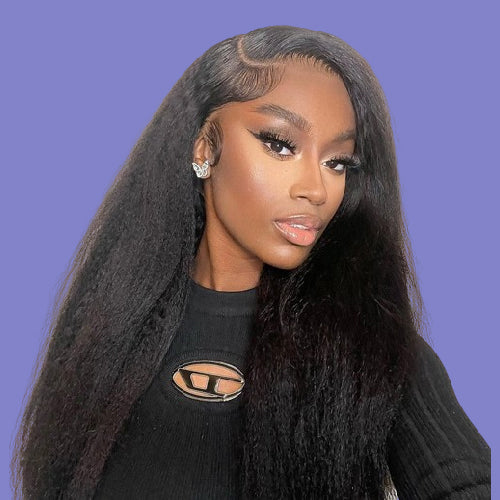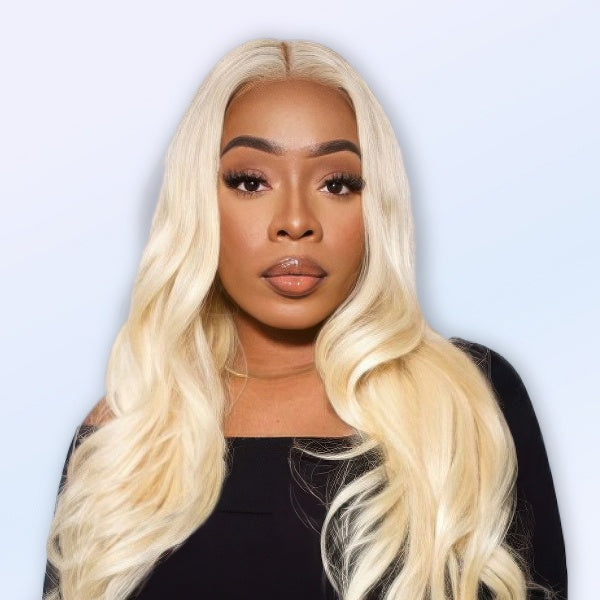How Long Can You Wear a Wig Without Taking It Off?
Whether you're looking to switch up your style or need an alternative hair option due to hair loss, human hair wigs provide a very natural and versatile solution. However, it's important to understand how long you can safely wear a wig without taking it off. Wearing a wig for too long can potentially lead to scalp irritation, hair loss, and other issues. This guide will cover everything you need to know about the recommended time frames for wig wear, factors that affect wig security, proper wig care, and signs that it's time to give your scalp a much-needed break.
Human Hair Wigs: Everything You Need to Know
Human hair wigs are made from real human hair that has been collected, sorted by texture and color, and then attached to a cap or base. This differs from synthetic wigs which are constructed from man-made fibers like polyester or nylon.
Advantages of Human Hair Wigs
There are several benefits to choosing human hair over synthetic for wig wear:
- Natural Look and Feel - Human hair falls, moves, and can be styled just like biological hair growing from your scalp for a completely natural appearance.
- Durability - With proper care, human hair wigs can last 1-2 years or longer before needing to be replaced.
- Styling Versatility - You can use heated styling tools, color, and chemically treat human hair wigs just like you would your own natural hair.
- Heat Resistance - Human hair can better withstand hot styling tools compared to synthetic fiber which can melt or become damaged.
- Breathability - The human hair cap allows for more airflow and breathability compared to the full wefted caps in some synthetic wigs.
Interested in learning more about why you should choose human hair over synthetic wigs? Our blog "Why Should You Choose Human Hair Wigs" offers more details.

Factors That Affect Human Hair Wig Wear Duration
Adhesion Methods
How long you can continuously wear a wig depends greatly on the adhesion method used to secure it. Common options include:
- Wig Grips/Bands - These adjustable bands grip the wig firmly but avoid heavy adhesives. With good wig construction, grips can keep it secure for 4-6 weeks with daily removal for cleaning.
- Double-Sided Tape - Wig tape is more adhesive than grips. It can keep a wig secured for 2-4 weeks before losing its stick and requiring wig removal.
- Liquid Adhesives - Glues like lace adhesive provide the longest hold of 4-8 weeks by adhering the lace front tightly to the skin's surface.
Skin Type Matters
Your natural hair and scalp conditions also play a role in wig wear duration:
- Oily Skin/Hair - Those with extra oily skin and scalp may need to remove their wig as frequently as every 7-10 days to avoid product buildup affecting the adhesion.
- Dry Skin/Hair - On the other hand, dry scalp environments allow adhesives to stay stuck longer. Wigs can potentially be worn for maximum recommended times.
Wig Fit and Construction
A properly fitted, well-constructed wig is also key for extended wear:
- Correct Measurements - Having your wig professionally measured and fitted ensures a secure, comfortable fit that won't loosen or shift prematurely.
- Cap Construction - Higher quality wig caps with durable yet breathable materials allow longer comfortable wear between removals.
Getting the right fit, adhesion method matched to your needs, and accommodating your skin type enables you to safely wear a human hair wig for longer periods.
Recommended Wig Wearing Time
Short-Term Daily Wear
For most wig wearers, removing the wig for cleaning and allowing the scalp to breathe overnight is recommended. Suggested maximum duration for daily, short-term wig wear is:
- 8-12 hours for those with normal scalp and skin conditions
- 6-8 hours for those with oilier skin/scalp types
Taking breaks allows your scalp to get air circulation and prevents potential issues from occurring.
Extended Wear Periods
In certain situations like vacations, work obligations, or special events, you may want to wear your wig for multiple days in a row. Extended, continuous periods of up to 3-4 weeks could be appropriate if:
- You have normal to dry scalp and skin
- The wig is well-fitted with a durable, breathable cap construction
- You are using a strong adhesive like wig glue or tape
- You practice good wig and scalp hygiene during wear
Continuous Long-Term Wear
Wearing any wig 24/7 without breaks is generally not recommended, as this can lead to issues like:
- Traction Alopecia - The constant tension and weight of the wig can gradually cause your natural hair to fall out from the scalp.
- Scalp Irritation/Infection - Lack of air exposure combined with moisture/sweat/product buildup can quickly cause problems like folliculitis or dermatitis.
No matter the duration, always listen to what your body is telling you and remove the wig at any signs of abnormal discomfort.

How Do You Care for Your Scalp and Hair Under the Wig?
Keeping Your Scalp Healthy
Wearing a wig creates a warm, moist environment that can quickly breed bacteria and fungus if not properly cared for. To avoid issues like folliculitis or dermatitis, it's crucial to:
- Allow Air Exposure - Remove the wig regularly to let your scalp breathe and stay dry.
- Keep it Clean - Gently cleanse your scalp and any natural hair with a mild shampoo every few days when wearing a wig long-term.
- Use Antimicrobials - Incorporate products with ingredients like tea tree oil or ketoconazole to inhibit fungal/bacterial growth.
Don't Neglect Exposed Natural Hair
For those leaving some natural hair out, your normal haircare routine is still important:
- Cleanse and Condition - Wash and deeply condition hair at least once a week to keep it moisturized and tangle-free under the wig cap.
- Protect at Night - Use a satin/silk scarf or bonnet at bedtime to reduce friction and keep natural hair from roughing up.
- Low Manipulation - Avoid constantly pulling or rearranging the natural hair too much as this can cause breakage.
By taking simple steps to allow airflow, keep the scalp clean, use antimicrobials when needed, and properly care for any exposed hair, you can safely wear wigs for longer periods without compromising hair and scalp health.
Tips for Longer, More Hygienic Wig Wear
Proper Cleaning Is Key
Regularly cleaning your wig is crucial for safe long-term wear and to preserve the hair quality:
- Shampoo Routinely - Gently shampoo the wig every 7-14 days, using cool water and a mild wig-safe shampoo. This prevents product/sweat buildup.
- Deep Conditioning - Follow with a wig conditioner or deep conditioning masque to replenish moisture and keep the hair silky.
- Air Drying - Always air dry wigs by laying them flat or hanging. Avoid excessive heat from blow drying.
Storage Matters Too
How you store your wig between wears also impacts its longevity:
- Cool, Dry Place - High heat and humidity can cause excessive drying and tangling. Store wigs in a cool, dry area.
- Wig Heads/Stands - Securing the wig on a vented, canvas wig head or stand prevents extreme creasing and crushed spots.
- Dry fully Before Storing - Make sure wigs are 100% dry before storing to prevent any mold, mildew or unpleasant odors.
See a Professional Stylist
Getting regular trims and maintenance from an experienced wig stylist has many benefits:
- Tangle Removal - They can safely remove tangles and freshen up the wig's appearance.
- Customized Styling - A stylist can teach you proper methods for cutting and styling the wig to your desired look.
- Wig Adjustments - They'll ensure the wig is fitted and adjusted correctly to prevent slipping or tension.
Following wig care best practices, proper storage habits, and getting professional maintenance all help human hair wigs look and perform their best for longer.
Signs It's Time to Remove Your Wig
Physical Discomfort
Your body will give you clear signals when it's time to remove the wig and let your scalp breathe. Pay attention to:
- Itchiness/Irritation - An itchy, irritated scalp means air exposure is needed.
- Head Pain - Headaches, tightness or pressure indicates the wig's tension is too much.
- Unexplained Soreness - Any soreness or tenderness under the wig requires a break.
Wig Adhesive Failure
The wig adhesives like tapes or glues allow for a secure fit, but will eventually begin to fail, signaling wig removal is needed:
- Lifting/Loosening - If you notice the wig no longer feeling tight and secure.
- Adhesive Breakdown - When adhesives start visibly flaking, leaving residue or not sticking well.
Poor Hygiene Signals
- Don't ignore basic hygiene issues - they indicate bacterial buildup requiring the wig to come off:
- Odors - Any foul, off-putting odors coming from under the wig cap.
- Sweat/Oil Buildup - When you start noticing excessive sweat or oils accumulating.
Listen to these physical cues from your body. Removing the wig at the first signs prevents bigger scalp health and hair issues down the line.

How to Make Wig Last Longer
Want to keep your wig looking great for as long as possible? Here are some unique tips to help your wig stay in top shape:
- Be Gentle When Styling: Always use a wide-toothed comb or a brush made for wigs. Start at the ends of the hair and work your way up slowly. This prevents pulling and keeps the hair smooth.
- Try Heatless Styling: Instead of using hot tools, try overnight styling methods. For curls, you can use soft rollers or twist the hair into small buns before bed. For waves, try braiding the hair. These methods are gentler on the wig and can create beautiful styles.
- Use a Silk Pillowcase: If you must sleep in your wig, use a silk or satin pillowcase. This reduces friction and helps prevent tangling and frizz.
- Rotate Your Wigs: If you can, use more than one wig and switch between them. This gives each wig a break and helps them all last longer.
- Protect from Sun and Chlorine: Just like your skin, wig hair can be damaged by too much sun. Wear a hat in strong sunlight. If you're swimming, wear a swim cap to protect your wig from chlorine and salt water.
- Refresh with Dry Shampoo: Between washes, use a dry shampoo made for wigs to absorb excess oil and keep the wig fresh. Spray it on the roots, wait a few minutes, then gently brush it through.
- Detangle Daily: Spend a few minutes each day gently detangling your wig. This prevents knots from building up and becoming harder to remove later.
- Use Leave-In Conditioner: A light leave-in conditioner can help keep wig hair soft and manageable. Just be sure to use one made for wigs and apply it sparingly to avoid buildup.
- Trim Regularly: Even wig hair can get split ends. A light trim every 6-8 weeks can keep the hair looking fresh and prevent further damage. You can do this yourself or visit a wig stylist.
- Store Properly When Traveling: If you're traveling with your wig, use a special wig box or case. This protects the wig from getting crushed or tangled in your luggage.
With these tips, you can keep your wig looking beautiful for much longer. Remember, treating your wig with care is the key to making it last!
Experience Confident, Healthy Wig Wearing
While incredibly versatile, extended wig wear requires care and awareness. Understand ideal durations for your needs, choose the right adhesion, and invest in quality wigs tailored to your scalp. Don't neglect scalp health - take breaks, gently cleanse, and control sweat/oil buildup. Practice proper wig hygiene through routine cleaning, smart storage, and professional maintenance. Most importantly, listen to bodily signals like itchiness, pain or odors indicating you need a break. By balancing wig styling with these tips, you can rock gorgeous wigs confidently while keeping hair and scalp in top shape.







Leave a comment